Consider the following questions:
1. You are an energy consultant with an active light commercial construction business. You have been asked to build a high performance building with better energy savings than a traditional wooden frame structure. ICF (Insulating Concrete Form) construction has become a core business for you. ICF is a system of reinforced concrete and rigid thermal insulation that stays in place as a permanent interior and exterior substrate for walls, floors and roofs. Below if an image of an ICF building block.
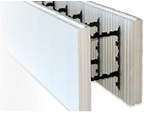
Recently you built an ICF tasting room for Willamette Vineyards and found that the building used 44 % less energy to heat and 32 % less energy to cool when compared to a LEED platinum wooden frame. In the graphs below you will find some general comparisons of ICF construction vs. Wood construction.
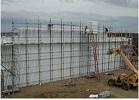
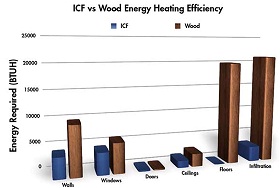
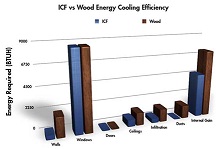
a. In conducting the performance audit on the tasting room, what steps did you use. List them below and briefly describe the actions you took.
b. As you review the graphs above, explain the energy advantages that you see displayed. Be sure to include both cooling and heating discussions.
c. In looking at the energy advantages, which LEED criteria (energy and what else?) would be applicable and how many LEED points in each category would you expect to see if you move ahead with the ICF construction project?
d. Your customer is not familiar with ICF construction. What might be some of the questions he/she would ask?
e. What tax incentives would you benefit from? List laws, regulations, and reference any websites that you would typically use to find the information.
2. As an energy professional, you used a thermal imager on a building to determine thermal loss, air leaks, and vent leaks. Below is a thermal image of a building. Describe what the image represents.
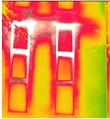
3. Ambient temperature should be taken into consideration when using a thermal imager.(True or False)
4. A client used a thermal imager on its equipment. Below is an image of a piece of equipment. Describe what the image represents.

5. Describe the components of a data logger and how they are used.
6. How can Reflectivity impact the accuracy of a thermal imager?
7. Thermal Imagers operate in the IR spectrum of light. (True or False)
8. A thermal imager is being used in Fairbanks, Alaska with an ambient temperature of minus 60 degrees F. Would you rely on the readings. (Yes or No). Explain your answer.
9. Emissions from buildings represent 48% of carbon dioxide emission in the US. (True or False)
10. When using a blower door, the combination of pressure and fan-flow measurements are used to determine the building tightness. (True or False)
11. According to ASTM C1060, for best insulation inspection results in a temperature difference, or Delta T, of at least 18 °F from the inside to the outside of a structure should exist (the larger the difference, the better).(True or False)
12. Name the four key requirements of LEED new construction?
13. It's St. Patty's Day and a leprechaun has found his pot of gold. He is trying to figure out how to invest his good fortune. His fellow leprechauns have many suggestions. In one case, the IRR is higher than the hurdle rate. Would this investment be profitable?(Yes or No)
14. Net Present Value (NPV) discounts the future total net cash flow over a project's life, and tells you what a project's future cash flow is worth in today's dollars. (True or False)
15. Explain why simple payback is not a good indicator of profitability.
16. Describe why you would bundle upgrades in an energy audit.
17. In 2006, the City of Ellensburg, WA invested in a solar energy park to benefit their ratepayers. The City of Ellensburg was the nation's first community solar project. Over the past few years, they have expanded the solar park 4 times. In recent years, the City Council also approved $75,000 in grant money to support solar projects for their customers.
During class, we learned about incentives available to both communities and ratepayers.
a. Which federal law(s) could the City have used to obtain incentives to build the first phase of the solar project?
Hint: the project started in 2006.
b. Which federal law(s) could the City have used to obtain financial support for subsequent phases of the project.
c. What tax incentives at the federal level are available to customers installing solar systems?
d. Extra : What incentives at the state level are available to ratepayers in Ellensburg?
18. Name three best practices in conducting an energy audit.
19. List two causes of sick building syndrome
20. In 2009, a significant piece of energy legislation was passed at the national level. This legislation provided funding for energy building code improvement. The name of this legislation is
21. Name the three critical levels in development of building codes.
22. What is meant by ICC?
23. What is ASHRAE and what is its role in energy code development?
24. Describe how building materials impact heat conductance.
25. Describe the purpose/objective of an energy audit.
26. Describe the difference between a Level 1 and Level 2 energy audit.
27. There are nine (9) major systems to consider in conducting an energy audit. List 4 of them.
28. List two intangibles that may come out of an energy audit.
29. Of the class presentations, which presentation illustrated to you a unique look at energy management?
30. What additional subject matter would you like to see in a future class on Energy Management?